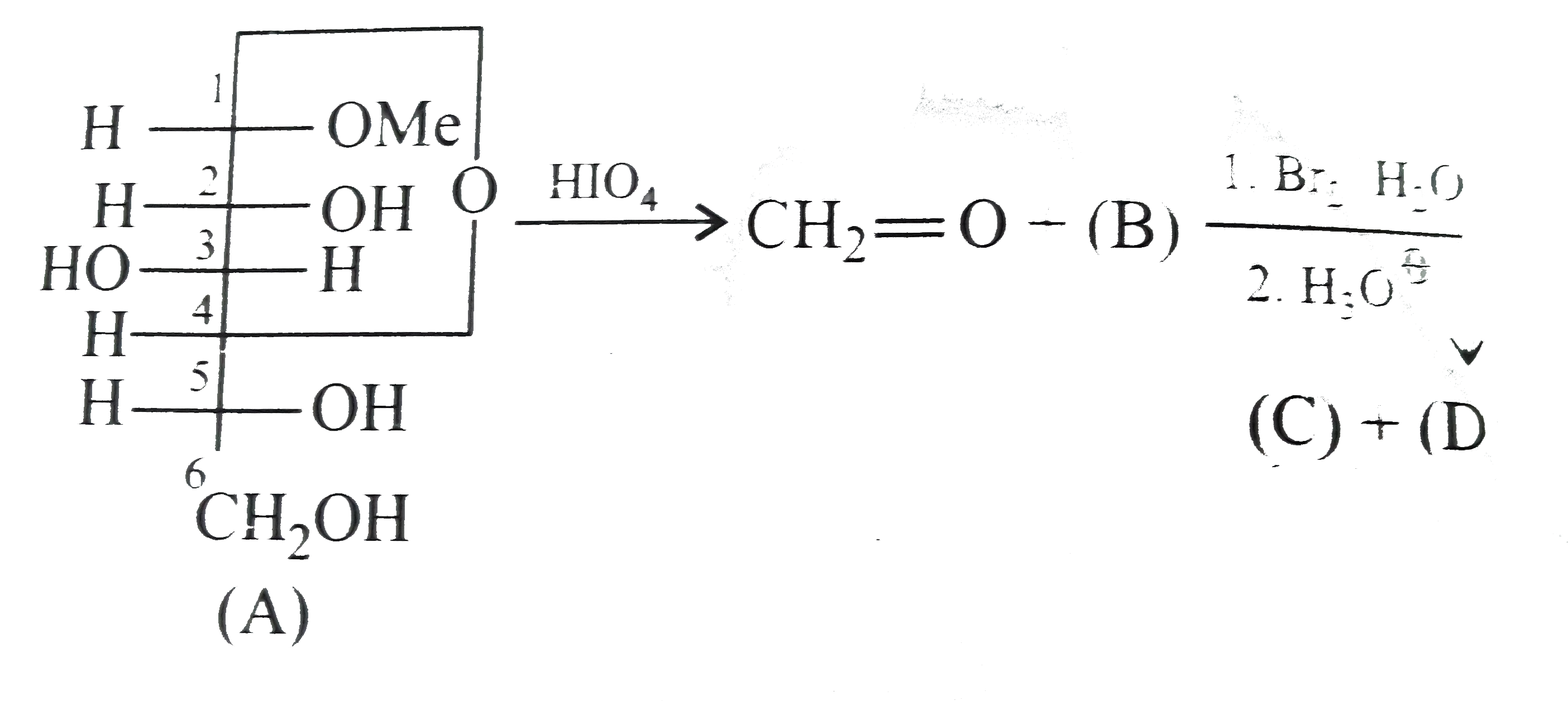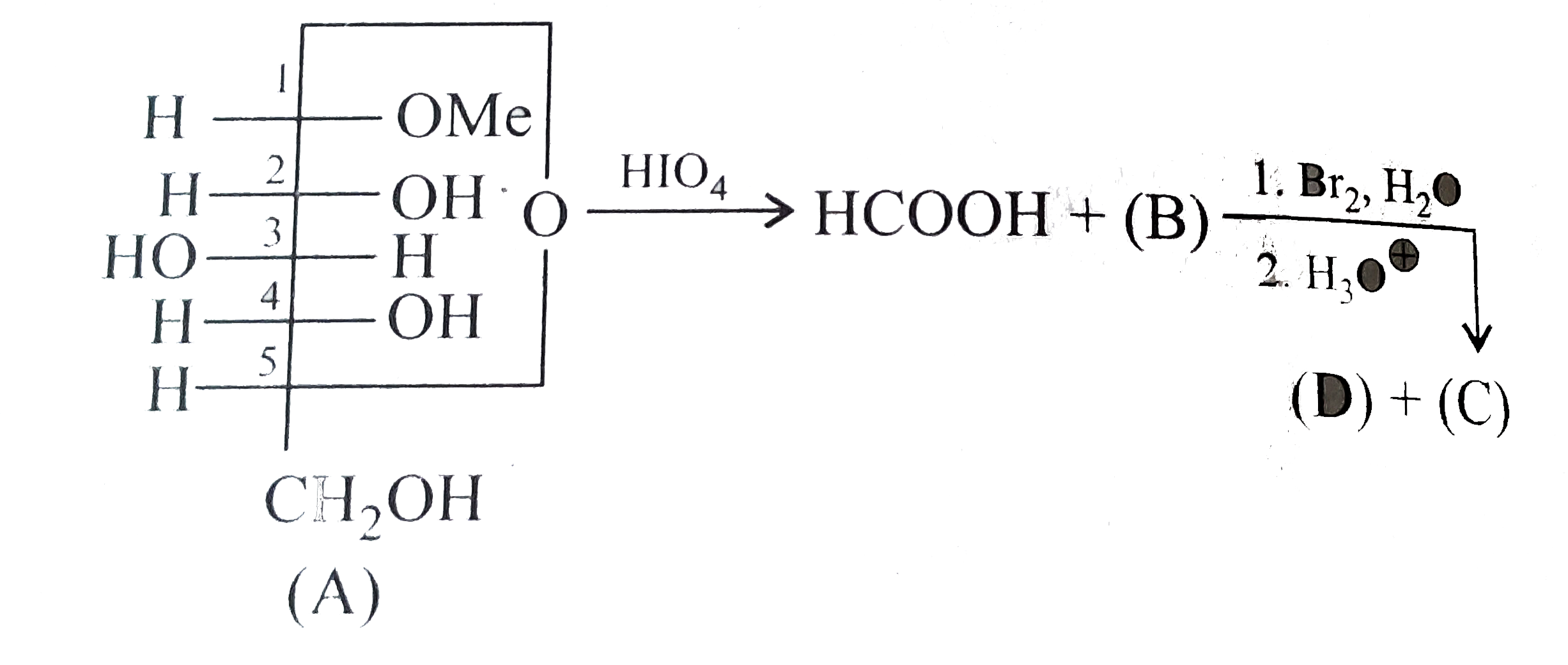Total number of moles of HlO4 required by one mole of D-glucose when it is subjected to periodic acid oxidation is
3
5
2
4
The correct Answer is:B
To determine the total number of moles of periodic acid (HIO₄) required by one mole of D-glucose during periodic acid oxidation, we can follow these steps:
Step 1: Understand the Structure of D-Glucose
D-glucose is a six-carbon sugar with the following structure:
- It has an aldehyde group (CHO) at one end.
- There are five hydroxyl (OH) groups attached to the carbon atoms.
Step 2: Identify the Reaction with Periodic Acid
Periodic acid (HIO₄) oxidizes D-glucose by cleaving carbon-carbon bonds and adding hydroxyl groups (OH) across the resulting carbonyl groups. The reaction can be summarized as follows:
- HIO₄ cleaves the C-C bonds in D-glucose.
- Each cleavage results in the formation of two moles of formic acid (HCOOH) or formaldehyde (CHO).
Step 3: Determine the Number of Cleavages
In the case of D-glucose, there are five carbon-carbon bonds that can be cleaved:
1. Between C1 and C2
2. Between C2 and C3
3. Between C3 and C4
4. Between C4 and C5
5. Between C5 and C6
Step 4: Calculate the Number of Moles of HIO₄ Required
Each cleavage of a carbon-carbon bond requires one mole of HIO₄. Since there are five carbon-carbon bonds in D-glucose, the total number of moles of HIO₄ required is:
- Total moles of HIO₄ = Number of cleavages = 5
Conclusion
Therefore, the total number of moles of HIO₄ required by one mole of D-glucose when subjected to periodic acid oxidation is 5 moles.
D-glucose is a six-carbon sugar with the following structure:
- It has an aldehyde group (CHO) at one end.
- There are five hydroxyl (OH) groups attached to the carbon atoms.
Periodic acid (HIO₄) oxidizes D-glucose by cleaving carbon-carbon bonds and adding hydroxyl groups (OH) across the resulting carbonyl groups. The reaction can be summarized as follows:
- HIO₄ cleaves the C-C bonds in D-glucose.
- Each cleavage results in the formation of two moles of formic acid (HCOOH) or formaldehyde (CHO).
In the case of D-glucose, there are five carbon-carbon bonds that can be cleaved:
1. Between C1 and C2
2. Between C2 and C3
3. Between C3 and C4
4. Between C4 and C5
5. Between C5 and C6
Each cleavage of a carbon-carbon bond requires one mole of HIO₄. Since there are five carbon-carbon bonds in D-glucose, the total number of moles of HIO₄ required is:
- Total moles of HIO₄ = Number of cleavages = 5
Therefore, the total number of moles of HIO₄ required by one mole of D-glucose when subjected to periodic acid oxidation is 5 moles.
Topper's Solved these Questions
- GENERAL ORGANIC CHEMISTRYBOOK - FIITJEECHAPTER - GENERAL ORGANIC CHEMISTRYEXERCISE - Section (II) [Jee mains]: With Single Correct Choice
78 Videos
- GENERAL ORGANIC CHEMISTRYBOOK - FIITJEECHAPTER - GENERAL ORGANIC CHEMISTRYEXERCISE - MORE THAN ONE CORRECT CHOICES
24 Videos
- GENERAL ORGANIC CHEMISTRYBOOK - FIITJEECHAPTER - GENERAL ORGANIC CHEMISTRYEXERCISE - SINGLE INTEGER ANSWER TYPE QUESTIONS
14 Videos
- GASEOUS STATEBOOK - FIITJEECHAPTER - GASEOUS STATEEXERCISE - MATCHING LIST TYPE QUESTION
1 Video
- HYDROCARBONSBOOK - FIITJEECHAPTER - HYDROCARBONSEXERCISE - SINGLE INTEGER ANSWER TYPE QUESTION
9 Videos
Similar Questions
Knowledge Check

The number of moles of HIO4 required in the above reaction is:AOneBTwoCThreeDFour
The number of moles of HIO4 required in the above reaction is:AOneBTwoCThreeDFourThe number of moles of KMnO4 required to oxidize one equivalent of Kl is the presence of sulfuric acid is-
A5B2C1/2D1/5
Number of moles of CH3−OH in acidic medium react with one mole of glucose .
View SolutionThe numbe of mole of MnO−4 required by 1 mole of ferric exalate for oxidation is/are-
View SolutionThe numbe of mole of MnO−4 required by 1 mole of ferric exalate for oxidation is/are-
View SolutionThe number of moles of KMnO4 required to oxidise 1mol of Fe(C2O4) in acidic medium is
View SolutionOne mole of glucose on complete oxidation in aerobic respiration yields ?
View Solution